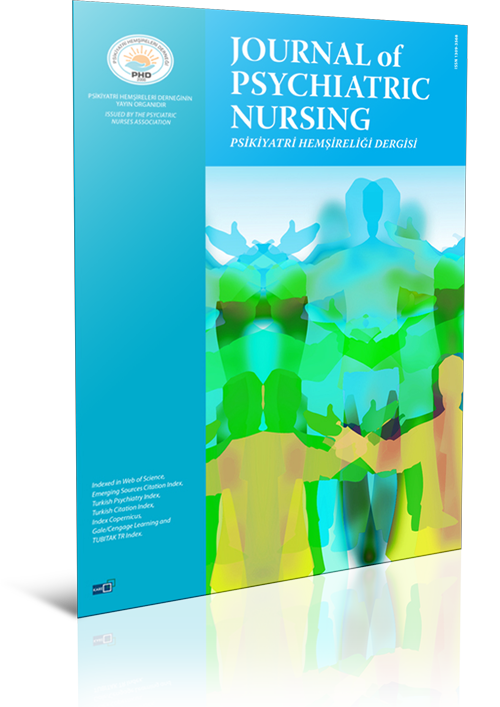
Volume: 7 Issue: 3 - 2016
| 1. | Frontmatter Pages I - III |
| EDITORIAL | |
| 2. | Editorial Nurhan Eren, Nazmiye Kocaman Yıldırım Page IV |
| RESEARCH ARTICLE | |
| 3. | Perceptions and Attitudes of Nurses Working At Emergency Unit About the Causes and Treatment of Addiction Elif Pilge, Leyla Baysan Arabacı doi: 10.5505/phd.2016.97658 Pages 105 - 113 INTRODUCTION: This study was carri ed out to determine the emergencynurses perceptions towards the reasons and treatment of substance addiction their attitudes towards the individuals having problem of substance addiction. METHODS: This descriptive study was carried out in three hospitals which have psychiatry clinic in a city in Aegean Region. 86 nurses, who was working in the emergency unit (n=125) and accepted participating, constituted the sample of the study. 4 Forms were used as data collection tools. Descriptive Information Form, Reasons of Substance Abuse Scale-RSAS, Substance Abuse Treatment Scale-SATS, and Attitude Scale-AS. In data evaluation, descriptive statistics, t-test, variance analysis, and correlation analysis were used. RESULTS: 53.5% of the nurses made care to a substance user patient in any period of their professional life and 80.2% of them explained that they havent had an education about that subject before. The Emergency unit nurses average scores of Attitude Scale (AS) was 49.43±19.59. showed that nurses has negative attitutes towards social distance to people who has substance use problem. The nurses socio-demographic and professional characteristics and having the knowledge and experience of caring to a substance user patient before, were effective negatively on the reasons for substance use and nurses perceptions about people who wants to give up on substance and nurses attitutes about substance users. Nurses believe that a person uses substance primarily because of coping with the problems and social environment and a substance user individual must have a change for him/her in order to be able to recover from addiction. They think that the individual must avoid the substance use and get socioprofessional help and must change the personality characteristics to achieve. DISCUSSION AND CONCLUSION: Emergency nurses have the tendency of negative attitude towards the patients having the problem of substance abuse. |
| 4. | An Evaluation of Sexual Attitudes of Nursing Students in Turkey Azize Atlı Özbaş, Nermin Gürhan, Veli Duyan doi: 10.5505/phd.2015.35002 Pages 114 - 120 INTRODUCTION: Sexuality is one of the important part of the holistic nursing. For the nurses, can provide sexual care, they should be aware of their attitudes towards sexuality and its effect on their care. The ideal period of time during which nurses can develop awareness and positive attitude towards sexuality is the training process. This study aims to determine the attitudes of nursing students towards sexuality. METHODS: The sample group of this descriptive research was 130 students from Gazi University Nursing School. The data gathered via self-reporting of a socio-demographic data form and The Trueblood Sexual Attitudes Questionnaire and analyzed by using frequencies analyze and independent variables t-test. RESULTS: As a result of this study; students can be considered as having conservative attitudes about sexuality. Second years students constituted the most conservative group while third years students were the most liberal. Students are more conservative about their own sexuality than others. DISCUSSION AND CONCLUSION: Our work, reveals that the attitude of nursing students towards sexuality in our sample is conservative and reveals that classical nursing training is not effective in developing a universal attitude, different than the attitude of the society, towards the subject. İt provides basis for possible future planing on studies towards changing the nursing students' attitudes towards sexuality in nursing training. |
| 5. | An Examination of the Relationship between Anger, Stress, Hopelessness and Perceived Social Support in Nursing Students Satı Dil, Burcu Aykanat Girgin doi: 10.5505/phd.2016.49379 Pages 121 - 128 INTRODUCTION: This study aims to examine the relationship between the levels of stress and feelings of anger and hopelessness experienced by nursing students and the perceptions they have of the provision of social support. METHODS: The study sample included 231 nursing students studying in the nursing department of a universitys Vocational School of Health from October to November, 2011. Data for the study were collected using a personal information form, the Hopelessness Scale, the Multidimensional Scale of Perceived Social Support, the Coping with Stress Scale and the State-Trait Anger Expression Inventory. For evaluation of the data, t test, ANOVA and Pearsons correlation analysis tests were used. RESULTS: Findings from the analysis showed that to cope with stress, female students engaged in social support activities and sought spiritual guidance, while male students applied passive coping mechanisms, such as denial, substance abuse and humor. The levels of perceived social support were determined to be higher in the students who were between the ages of 19 and 21 (p<0.05), and the anger-in scores were found to be higher in the students who were between the ages of 22 and 24 and in fourth-year students (p<0.05). Students whose parents held strong democratic attitudes were demonstrated to have low levels of hopelessness and higher perceptions of social support (p<0.05). DISCUSSION AND CONCLUSION: The increased number of effective coping mechanisms for dealing with stress and the higher positive perceptions of social support in nursing students leads to the development of suitable behavior for coping with stress and the diminishment of feelings of hopelessness. The study found that when nursing students have a greater perception of social support they express their anger in an appropriate way and are able to cope with stress effectively. Therefore, it is recommended that relevant training programs be organized to individually empower students. |
| 6. | Determination of the Mental Disorder Beliefs of Students in a Nursing Faculty Seren Günay, Tuğba Bekitkol, Gizem Beycan Ekitli, Serap Yıldırım doi: 10.5505/phd.2016.43534 Pages 129 - 134 INTRODUCTION: This study planned to determine nursing students beliefs toward mental disorders and effective factors on these beliefs. METHODS: A descriptive study carried out 240 students which was studying at Ege University during the academic year 2014-2015 and was taking mental health nursing course. The data were collected by Descriptive Information Form and Beliefs toward Mental Illness Scale (BMI). In the analyses of the data student t test and One Way Anova analysis were used. RESULTS: The average age of students were 22.47±1.37 years; of all participants were 86.2% women, 69.2% in third and 30.8% in fourth grade, 67.9% not fulfill mental health nursing courses practice, %82.1 had any family member suffer from mental disorders, 62.5% had anyone with suffer from mental disorders, 92.1% had any mental disorder diagnosis for him/herself ever and 94.2% worked with any civil society organization related with mental disorders. Students average score of BMI subscales was 27.05±7.69 for Poor social and interpersonal skills and incurability, 18.54±5.17 for Dangerousness, 2.03±2.59 for Shame and 50.55±12.64 for total scale. It is found that students distribution of BMI total score was statistically significant only if they have any family member or know someone around him/her with mentally ill (p<0.05); there was no significantly difference in age, gender, grade, carrying on any mental health nursing practice, having any mental disorders diagnoses and working with a civil society organization. DISCUSSION AND CONCLUSION: Because of having an impact directly on clients treatment and care and indirect impact on community burden, its important to identify students beliefs toward mental disorders as a futures health professional and to strengthen students self-awareness in this field. |
| 7. | Nursing Students Death Anxiety, Influencing Factors and Request of Caring For Dying People Merve Şahin, Fatma Demirkıran, Filiz Adana doi: 10.5505/phd.2016.66588 Pages 135 - 141 INTRODUCTION: This study is conducted to determine nursing students death anxiety, request of caring for dying people and influencing factors. METHODS: Cross-sectional planned research was conducted at Aydın Health College of Adnan Menderes University, in April and May 2014. Research field consisted of Nursing Departmen students and the research sample comprised of two hundered and thirty tree nursing students. Research data was collected with personal information form and Thorson-Powell Death Anxiety Scale. Complimentory statistics, chi-square and student-t test were used during the analysis of the data. RESULTS: The avarage age of the nursing students is 20.08±1.36. 82.4% of students were female and %17.6 were male. It was understood that most of the students define death as a new begining and they feel sadness after the death of the paticient that they care for. 75% of students indicated that they dont want to care for a dying patient while 25% of students expressed they were eager to care for. The avarage of all students death anxiety point is 59.15±14.94. It was found that female students compared to male students and students who lost someone they know, compared to students who dont, were less eager to care for a dying patient. The death anxiety of female students was found higher compared to male students. It is determined that most of the nursing students crying reaction and apply praying method in order to cope with the sorrow. DISCUSSION AND CONCLUSION: This study indicates that more than half of the students encoenter death at any term of their lifes, this situation increases death anxiety and students with high death anxiety dont want to care for a dying patient. This study also points out that students who are going to be health care staff need consulting service to decrease death anxiety and education in which they efficiently use coping methods. |
| REVIEW | |
| 8. | A Sample Individual Psychoeducation Model for Bipolar Disorder Funda Gümüş, Sevim Buzlu, Sibel Çakır doi: 10.14744/phd.2016.27928 Pages 142 - 147 Individual psychoeducation model for bipolar disorder is a four-session program aiming to provide various knowledge and skills to bipolar disorder patients about their disorder and developed by the authors and can easily be applied by practitioners and researchers working in this field. The program consists of four sessions; introduction to the psychoeducation program and information about the disorder, symptoms, developing an emergency plan to prevent the recurrence of the disorder and legal rights, assessing effects and side effects of drugs, and communication and problem-solving skills. The purpose of this study is to introduce the individual psychoeducation model for bipolar disorder and mention the results of similar psychoeducation studies. The results of the study show that the individual psychoeducation program for bipolar disorder may be an appropriate and effective program for patients. |
| 9. | An Intervention Program For Children Against Turn Into Crime: Aggression Replacement Training Fadime Kaya, Sevim Buzlu doi: 10.5505/phd.2016.27247 Pages 148 - 151 Aggression Replacement Training (ART) is a multi-component psychoeducational intervention program that aims to provide alternative behavior for chronic aggressive adolescents. The content of the program has components of social skills training to provide constructive behavior, anger control training to reduce the anger level and to ensure self-regulation, and moral reasoning training to provide the ability to see the perspective of others. This paper is included effectiveness of introducing ART, besides of evaluating numerous researches about ART. These data shows that ART is an appropriate and effective intervention program for children against turn into crime. |
| 10. | Managers Blind: Humor Handan Alan, Hanife Tiryaki Şen doi: 10.5505/phd.2016.55265 Pages 152 - 156 Humor is a common element of human interaction and therefore has an impact on work groups and organizations. Despite the belief that business is serious, humor can lighten the mood within organizational environments and make work life more enjoyable. Humor has been described as an important component of organizational culture by creating a positive environment in which knowledge and ideas are shared freely and interpersonal relationships can flourish. Despite this, managers often fail to take humor seriously or realize its numerous benefits. Indeed, the proper use of organizational humor can provide valuable benefits to organizationsand even more valuable tools to management for motivating staff, communicating effectively, and mitigating discord. Humor is more than just funny concepts; it represents a multifunctional management tool that can be used to achieve many objectives. Managers can select the appropriate humor style suitable for the desired organizational outcome, adjust for individual differences, and achieve positive organizational outcomes. This article describes how nurse managers can use humor to reduce stress and enhance leadership, group cohesiveness, communication, creativity, and organizational culture. |
| LETTER TO THE EDITOR | |
| 11. | Psychiatric Nursing in Turkey Real or a Myth? Besti Üstün doi: 10.5505/phd.2016.29290 Pages 157 - 162 Abstract | English Full Text |


















